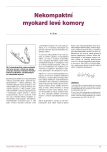-
Medical journals
- Career
Hypertension in children and adolescents
Authors: T. Seeman
Authors‘ workplace: Pediatrická klinika 2. LF UK a FN v Motole, Praha ; doc. MUDr. Tomáš Seeman, CSc.
Published in: Kardiol Rev Int Med 2006, 8(1-2): 36-43
Category: Editorial
Overview
Arterial hypertension is one of the major risk factors of cardiovascular diseases which are, in turn, the most frequent mortality cause in adult population. Prevalence of child hypertension is significantly lower (ca 1%) as compared with adult hypertension. Also, its underlying causes widely differ from adult hypertension. In children, secondary hypertension is observed much more often, whereas adolescent patients suffer more frequently from primary hypertension. Generally, it can be said that the probability of incidence of secondary hypertension increases with lower age and higher blood pressure. Most often, child secondary hypertension is caused by renal disorders (renoparenchymal or renovascular hypertension). Other causes of secondary hypertension are cardiac disorders (coarctation of aorta in particular), endocrinopathy or central nervous system damage. Every hypertensive child must undergo close examination whose scope is determined by child's age and hypertension seriousness. The main diagnostic goal is to reveal possible secondary hypertension and start its causal therapy. Besides causal therapy of secondary hypertension, hypertension treatment should include both non-pharmacological and pharmacological therapies.
Keywords:
hypertension – blood pressure – children – adolescents
Sources
1. Guidelines Committee. 2003 European Society of Hypertension - European Society of Cardiology guidelines for the management of arterial hypertension. J Hypertens 2003; 17 : 151-183.
2. Cífková R, Horký K, Widimský J sr et al. Doporučení diagnostických a léčebných postupů u arteriální hypertenze - verze 2004. Vnitř Lék 2004; 50 : 709-722.
3. Report of the Second Task Force on Blood Pressure Control in Children - 1987. Task Force on Blood Pressure Control in Children. Pediatrics 1987; 19 : 1-25.
4. Update on the 1987 Task Force Report on High Blood Pressure in Children and Adolescents: a working group report from the National High Blood Pressure Education Program. National High Blood Pressure Education Program Working Group on Hypertension Control in Children and Adolescents. Pediatrics 1996; 98 : 649-658.
5. National High Blood Pressure Education Program Working Group on High Blood Pressure in Children and Adolescents. The fourth report on the diagnosis, evaluation, and treatment of high blood pressure in children and adolescents. Pediatrics 2004; 114 : 555-576.
6. Seeman T, Palyzová D, Dušek J, Janda J. Reduced nocturnal blood pressure dip and sustained nighttime hypertension are specific markers of secondary hypertension. J Pediatr 2005; 147 : 366-371.
7. Seeman T, Janda J. Praktické využití ambulantního 24hodinového monitorování krevního tlaku (ABPM) v diagnostice a léčbě hypertenze u dětí. Čes slov Pediat 1998; 10 : 628-632.
8. Sorof JM, Portman RJ. Ambulatory blood pressure monitoring in the pediatric patient. J Pediatr 2000; 136 : 578-586.
9. Rocchini AP, Katch V, Anderson J. Blood pressure in obese adolescents: effect of weight loss. Pediatrics 1988; 82 : 16-23.
10. Gutin B, Basch C, Shea S. Blood pressure, fitness and fatness in 5 - and 6-year-old children. JAMA 1990; 264 : 1123-1129.
Labels
Paediatric cardiology Internal medicine Cardiac surgery Cardiology
Article was published inCardiology Review

2006 Issue 1-2-
All articles in this issue
- Cell therapy in cardiology: state of the art 2005
- Sudden cardiac death: how to prevent it
- Some patient groups with an acute heart attack subjected to an increased risk or requiring a specific therapeutic and diagnostic approach
- Acute myocardial infarction in young patients: etiology, risk factors, genetics
- Blood pressure measurement at home
- Hypertension in children and adolescents
- Non-pharmacologic therapy of arterial hypertension
- Inflammatory and viral cardiomyopathies
- Role of two-dimensional echocardiography in diagnostics of hypertrophic cardiomyopathy
- Diagnostic possibilities of peripheral arterial disease
- Acute aortic regurgitation in conditions of Nigeria: case report
- The quadricuspid aortic valve – rare echocardiographic findings: case report
- Cardiology Review
- Journal archive
- Current issue
- Online only
- About the journal
Most read in this issue- Hypertension in children and adolescents
- Diagnostic possibilities of peripheral arterial disease
- Sudden cardiac death: how to prevent it
- Non-pharmacologic therapy of arterial hypertension
Login#ADS_BOTTOM_SCRIPTS#Forgotten passwordEnter the email address that you registered with. We will send you instructions on how to set a new password.
- Career

